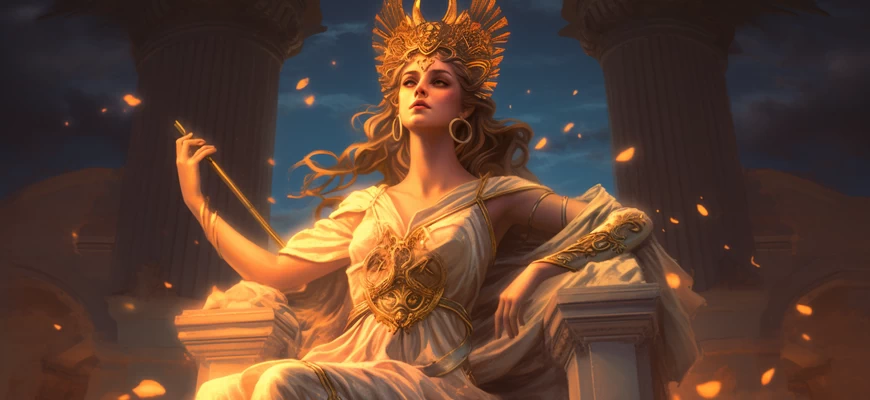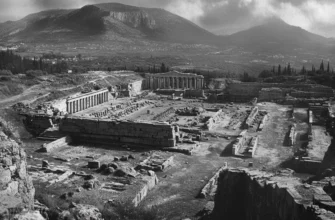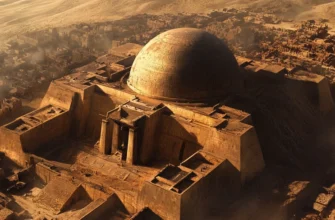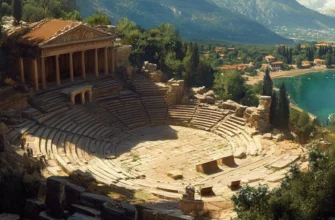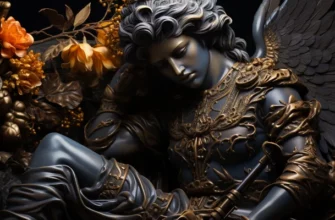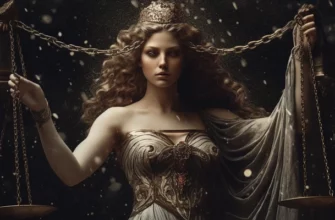Hera, one of the most famous goddesses in ancient Greek mythology, was known as the ruler of marriage and family. She was the patroness of female wisdom and motherhood. Hera had a complicated relationship with her husband, the god Zeus, and was often the cause of intrigue and conflict with other goddesses. She was also depicted in many works of art and literature. The modern perception of Hera remains a subject of debate, and her symbolism is significant in the modern world.
- The mythological origins of Hera
- Role and attributes of Hera
- Ruler of marriage and family
- Patroness of female wisdom and motherhood
- The legendary deeds of Hera
- Intrigues and disputes with other goddesses
- Hera and Zeus: myths and relationships
- Depictions of Hera in art and literature
- Painting, sculpture, and other visual representations
- Hera’s role in Greek poetry and drama
- The meaning and symbolism of Hera in the modern world
- Hera’s influence on modern culture and feminist discussions
- Conclusion
The mythological origins of Hera
Hera’s mythological origins are linked to Greek mythology. According to legend, Hera was the daughter of Cronus and Rhea, and the sister of the gods Zeus and Poseidon.
She married her brother Zeus, becoming his wife and queen of Olympus. Her marriage to Zeus symbolized the union of heavenly and earthly power. Hera played an important role in the Greek pantheon of gods, acting as the goddess of marriage, family, and childbirth.
Hera is known not so much for her heroic deeds as for her characteristics and role in mythology. She was known for her power, pride, and authority. Hera acted as the protector of marriage and family, she was the guardian of marital bonds and fidelity between partners. She was also the patroness of female wisdom, motherhood, and the birth of children. However, her story is often associated with intrigue, jealousy, and conflicts with other goddesses and women, especially because of her relationship with her husband, Zeus.
Role and attributes of Hera
In ancient Greek mythology, Hera was the goddess of marriage and family. She was the patroness of married couples and kept marriages faithful and stable. Hera’s attributes included a crown or diadem, a symbol of her power, and a scepter, which she held as a sign of her authority over women’s affairs. She was also often depicted with a peacock, symbolizing beauty and grandeur. Hera was recognized as the patroness of motherhood, protecting pregnancy and childbirth. Her role in the Greek pantheon of gods was extremely important, and she performed her duties with great dignity and power.
Ruler of marriage and family
In ancient Greek mythology, Hera was the ruler of marriage and family. She was very important in protecting marital bonds and spouses. Hera was a symbol of fidelity, mutual understanding, and stability in marriage. Her role was to support and preserve family well-being. As the ruler of the family, she was the patroness of childbirth and protected motherhood. Hera played an important social role in ancient Greek society, encouraging respect and appreciation for the institution of marriage and family.
Patroness of female wisdom and motherhood
In ancient Greek mythology, Hera was the patroness of female wisdom and motherhood. She acted as a goddess who gave women wisdom and understanding in family matters, raising children, and managing the household. Hera played an important role in supporting and protecting motherhood, protecting pregnancy and childbirth. She was a symbol of maternal strength and tenderness, and also gave women confidence and strength in their role as mothers.
The legendary deeds of Hera
Hera’s legendary exploits are not a major aspect of her mythology. However, there are several stories associated with her. For example, Hera took part in mythological events such as the war against the Titans and the Giants, where she supported Zeus. There are also incidents where Hera drove her son Heracles mad as a result of a conflict with her husband Zeus. She was also involved in numerous quarrels and intrigues with other goddesses, notably Aphrodite and Athena. Although Hera’s legendary exploits are not as well known as her role as the ruler of marriage and motherhood, they add depth to her character and interactions with other gods and goddesses in Greek mythology.
Intrigues and disputes with other goddesses
Hera is known in ancient Greek mythology for her intrigues and disputes with other goddesses. For example, she had a tense relationship with Aphrodite, the goddess of beauty and love, due to their conflict over influence over Zeus. Hera also quarreled with Athena, the goddess of wisdom and war, over issues of power and dignity. These disputes often led to intrigue and conflict among the goddesses and gods of Olympus. They added tension and drama to mythology and showed the complexity of the relationships between the deities.
Hera and Zeus: myths and relationships
In mythology, Hera and Zeus are depicted as brother and sister who married each other. Their relationship was complicated and full of twists and turns. Zeus, as the god of the sky and thunder, was known for his numerous affairs and betrayals. This caused Hera to be jealous and resentful, and she often took measures to preserve her power and status as queen of Olympus. This led to conflicts between them, but also to moments of harmony and reconciliation. Despite all the turmoil, Hera remained faithful to her husband and retained her role as ruler of marriage and family.
Depictions of Hera in art and literature
Hera, the ancient Greek goddess, was often depicted in art and literature. In sculpture and painting, she was often portrayed as a majestic woman with a crown or diadem on her head, holding a staff or scepter symbolizing her power. Her image reflected dignity, strength, and power. In literature, Hera is mentioned in Homer’s epics, the Iliad and the Odyssey, where her role and interactions with other gods and heroes are revealed in the form of epic tales. Hera is also mentioned in the works of other ancient Greek writers, who contribute to the multifaceted nature of her image in literature.
Painting, sculpture, and other visual representations
Visual representations of Hera in painting and sculpture can vary, but she is often depicted as a majestic woman with a crown or diadem on her head, symbolizing her power and grandeur. Her hair may be wrapped around her head or left loose. Hera may hold a staff or scepter in her hands as symbols of her power and authority. She is often depicted in luxurious clothing or covered with a cloak.
In painting and sculpture, images of Hera may be presented alone or in compositions with other goddesses or gods. For example, she may be depicted alongside her husband Zeus or in a family context with their children.
In addition, Hera may be depicted in stained glass, mosaics, and other art forms. Her image may vary depending on the period, artistic style, and individual interpretation of the artists.
Hera’s role in Greek poetry and drama
Hera played an important role in Greek poetry and drama. She is often mentioned in the works of ancient Greek poets, particularly in Homer’s epics, the Iliad and the Odyssey, where her presence is revealed through her interactions with other gods and heroes. She can influence events and relationships between characters, creating conflict and intrigue.
Hera also has important moments in Greek drama. She can be portrayed as a principled character or mentioned through her relationships with other gods and heroes. Hera can act as a regulator, creating conflicts, but she can also be a catalyst for the development of characters and their destinies.
All these variations in Hera’s role in Greek poetry and drama add depth and intrigue to the works, as well as revealing the complexity of the relationships between gods and humans in the Greek mythological world.
The meaning and symbolism of Hera in the modern world
Hera, as an ancient Greek goddess, has her own meaning and symbolism that can play a role in the modern world. The main aspects associated with Hera include:
Ruler of marriage and family: Hera symbolizes the importance of family values, devotion, and fidelity in relationships. She can serve as a reminder of the importance of supporting and maintaining healthy and happy family ties.
Motherhood and feminine wisdom: Hera is the patroness of motherhood and a symbol of feminine wisdom. Her image can inspire women to develop their inner potential, understand the importance of family life, and take responsibility for raising the next generation.
Power and authority: Hera possesses power and authority, which can inspire the development of leadership qualities and self-confidence. She can serve as a symbol of strength, distinction, and confidence in one’s abilities.
Dignity and elegance: Hera is depicted as a majestic and elegant goddess who can inspire the development of aesthetic taste, dignity, and style in the modern world.
Although Hera’s role and symbolism may vary depending on cultural context and interpretation, her aspects can inspire us to pursue high moral values, family well-being, the development of female strength and power, as well as confidence and elegance in modern life.
Hera’s influence on modern culture and feminist discussions
Hera, as the goddess of marriage, family, and female wisdom, has an influence on contemporary culture and feminist discourse. Here are a few aspects that can be noted:
Reinterpretation of Hera: In contemporary reflections on mythology and feminism, Hera can be reinterpreted as a symbol of power, independence, and strength for women. She can serve as an example of female power that contrasts with the traditional view of women as weak and submissive.
Analysis of family relationships: Looking at Hera as the ruler of marriage and the family can prompt an examination of modern family dynamics, roles, and interactions. This can lead to discussions about gender equality, the division of labor, and the importance of partnership in the family.
Critique of stereotypes: Hera’s role in mythology can be used to criticize stereotypes about women’s roles in society. This can highlight the need to rethink traditional ideas about women’s behavior and expectations.
Supporting women’s self-determination: Looking at Hera as a symbol of female wisdom and independence can help women develop self-awareness and self-determination. This can strengthen discussions about the importance of women’s independence and influence in various spheres of life.
All of this contributes to the expansion of Hera’s role in contemporary culture and feminist discussions, helps to rethink traditional ideas about femininity, stimulates a rethinking of roles, and promotes the fulfillment of women’s potential in modern society. Various creative reinterpretations and adaptations of Hera in literature, art, and cinema also contribute to the spread of her influence on contemporary culture. This opens up new avenues for discussing gender issues, the power of the female voice, and the importance of equality in society.
Conclusion
Hera, an ancient Greek goddess, played an important role in Greek mythology and culture. Her symbolism and significance can be viewed from different perspectives. She embodied the concepts of marriage, family, motherhood, female wisdom, power, and authority. Her image is used to reflect on the roles of women in the family and society, stereotypes that need to be revisited, and the development of women’s self-determination. Hera’s influence on contemporary culture and feminist discourse highlights the importance of understanding and rethinking femininity, women’s roles, and status in society today.
